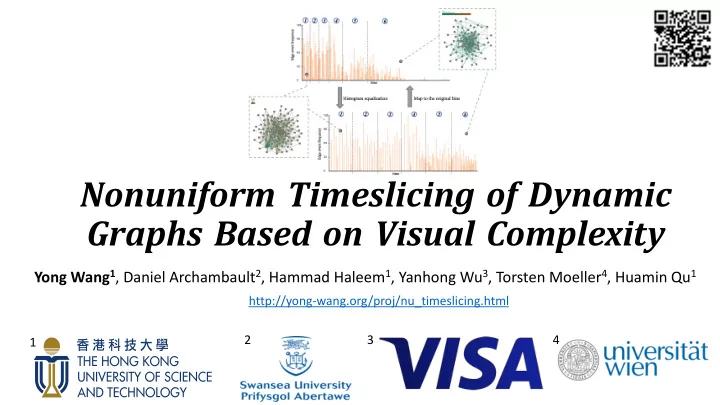

Nonuniform Timeslicing of Dynamic Graphs Based on Visual Complexity Yong Wang 1 , Daniel Archambault 2 , Hammad Haleem 1 , Yanhong Wu 3 , Torsten Moeller 4 , Huamin Qu 1 http://yong-wang.org/proj/nu_timeslicing.html 2 3 4 1
Background • A dynamic graph is a sequence of graph snapshots defined over an edge stream • Uniform timeslicing divides time into equal intervals and is usually used in dynamic graph visualization for convenience and simplicity 2
Background • For dynamic graph visualization, uniform timeslicing: - Does not take the data into account - Can generate cluttered timeslices with bursting edges, and empty timeslices with few edges 3
Research Problem • How can we make full use of the limited number of timeslices to show more meaningful information? • How can we provide users with better perception of the dynamic graph (especially the periods with bursting edges)? 4
Nonuniform Timeslicing • Goal: create timeslices of similar visual complexity A simple definition of visual complexity: number of edges 5
Nonuniform Timeslicing • Solution: nonuniform timeslicing based on histogram equalization, a technique for enhancing image contrast 6 https://www.tutorialspoint.com/dip/histogram_equalization.htm
Nonuniform Timeslicing • Image contrast enhancement vs. dynamic graph visualization Image Contrast Enhancement Dynamic Graph Visualization Problems Low color contrast Visual clutter in some timeslices Causes Color convergence in certain color Edge bursting in certain time range range Solutions Re-distribute color bins for equal How ??? distribution 7
Nonuniform Timeslicing For Dynamic Graphs • Adapt histogram equalization to redistribute edge counts across time For the i-th bin in the original time series, histogram equalization will transform it to the following bin: , T is the total time range, 𝐹 " is the number of edge events in the i-th bin and 𝐹 is Where the total number of edge events. 8
Nonuniform Timeslicing For Dynamic Graphs • Visual hint for time information - An explicit time legend for each graph snapshot 9
Nonuniform Timeslicing For Dynamic Graphs 1 2 3 4 5 6 One example Edge event frequency time Histogram Map to the original equalization bins 1 2 3 4 5 6 Edge event frequency 10 time
Evaluation – Qualitative Case Study • Rugby dataset --- uniform timeslicing 4 5 6 1 2 3 7 8 9 10 11 12 - Intervals1, 2, 3, 9: sparse edges - Intervals 11, 12: dense edges, hindering users from checking details 11 https://arxiv.org/abs/1709.00372
Evaluation – Qualitative Case Study • Rugby dataset --- nonuniform timeslicing 6 4 5 3 2 1 8 7 9 10 12 11 - Intervals 8: sparse interactions (summer break from may to August) - Intervals 9-12: dense interactions (the season begins) - Reveal more details: “ sc ” interacted most with different teams along time 12
Summary and Discussion • Compared with uniform timeslicing, the proposed nonuniform timeslicing can achieve - Balance visual complexity across intervals - Reveal more details in the intervals of bursting edges • Limitations - Scalability issues: visual clutter can be reduced but cannot be always removed - Application: more suitable for dynamic graphs with edge event variations 13
Nonuniform Timeslicing of Dynamic Graphs Based on Visual Complexity Yong Wang 1 , Daniel Archambault 2 , Hammad Haleem 1 , Yanhong Wu 3 , Torsten Moeller 4 , Huamin Qu 1 http://yong-wang.org/proj/nu_timeslicing.html 2 3 4 1
Recommend
More recommend